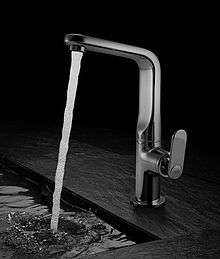Air gap (plumbing)
An air gap, as it relates to the plumbing trade, is the unobstructed vertical space between the water outlet and the flood level of a fixture.[1] Air gaps of appropriate design are required for water safety by legislation in many countries. A related term in computer security is Air gap (networking).

A simple example is the space between a wall mounted faucet and the sink rim (this space is the air gap). Water can easily flow from the faucet into the sink, but there is no way that water can flow from the sink into the faucet without modifying the system. This arrangement will prevent any contaminants in the sink from flowing into the potable water system by siphonage and is the least expensive form of backflow prevention.
A common use of the term "air gap" in home plumbing refers to a fixture that provides back-flow prevention for an installed dishwasher. This "air gap" is seen above the sink as a small cylindrical fixture mounted parallel with the faucet. In the base cabinet under the sink, the drain hose from the dishwasher feeds the "top" of the air gap, and the "bottom" of the air gap is plumbed into the sink drain below the basket, or into a garbage disposal unit. When installed and maintained properly, the air gap works as described above, and prevents drain water from the sink from backing up into the dishwasher, possibly contaminating dishes.
To further illustrate the air gap, consider what could happen if the air gap were eliminated by attaching a hose to the faucet and lowering the hose into a sink full of contaminated water. Under the right conditions (if the water supply loses pressure and the sink is higher than the point at which the water supply enters the house, for instance), the dirty water in the sink will be siphoned into the water pipes through the hose and faucet. The dirty water then will be dispersed throughout the drinking water system.
Standards and codes
All plumbing codes require backflow prevention in several ways. The fixtures are manufactured to meet these codes. Plumbers must not build cross-connections in their daily work practices, and plumbing inspectors look for improper designs or connections of piping and plumbing fixtures. A common misconception is that a "high loop" (routing a drain line above a sink's flood level, for instance) will provide the same function as an air gap; this is not true, because the continuous connection in such a case still will allow backflow through siphoning.
According to the International Residential Code 2003, an air gap must meet the requirements of being two times the effective inner diameter of the pipe (2*D) in order to be sufficient.[2]
A standard widely use in the United States is:
- A112.1.2 Air Gaps in Plumbing Systems (For Plumbing Fixtures and Water-Connected Receptors)
In the United Kingdom, legislation is by statutory instrument and vary by country, but include Water Supply (Water Quality) Regulations 2016 and Water Supply (Water Quality) Regulations (Wales). The categorisation of air gaps is standardised by European standards, which cover the basic design and dimensions for appropriate to different uses.
- EN 13076 -- Devices to prevent pollution by backflow of potable water - Unrestricted air gap - Family A - Type A
- EN 13077 -- Devices to prevent pollution by backflow of potable water - Air gap with non-circular overflow (unrestricted) - Family A - Type B
- EN 13078 -- Devices to prevent pollution by backflow of potable water - Air gap with submerged feed incorporating air inlet plus overflow - Family A, type C
- and others for each family and type of air gap
See also
- Hydrostatic loop
- Pressure vacuum breaker
- Double check valve
- Chemigation valve
- Reduced pressure zone device
- Atmospheric vacuum breaker
- Upstream contamination
References
- International Residential Code 2003 (1st ed.). Definition: AIR GAP, WATER–DISTRIBUTION SYSTEM: International Code Council. 2003. p. 9. ISBN 978-1-892395-58-0.
- International Residential Code 2003 (1st ed.). Paragraph P2902.2.1 Air gaps: International Code Council. 2003. p. 402. ISBN 978-1-892395-58-0.CS1 maint: location (link)